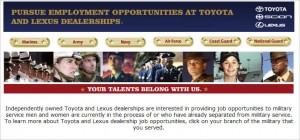The unemployment rate among U.S. veterans of Iraq and Afghanistan has been increasing every year—all the way from 6.1% in 2007 to 14.7% in March, 2010.
Obviously, unemployment is higher overall in 2010. But in March the composite national rate was about 10%, which means there’s a big difference between vets and most other groups.
A recent USA Today story cites three specific reasons for the high rate of veteran unemployment:
1. Difficulty in translating military skills to civilian job requirements
2. Employer worries that reservists will be redeployed
3. Employer concerns about post-traumatic stress disorder (PTSD)
Reason 2 is just plain practical, from an employer viewpoint—and while very large companies can absorb the absence of employees during deployment, it’s a tougher call for small organizations. But Reasons 1 and 3 are more complicated.
USA Today notes that vets often have skills that would be very valuable to business, but the skills don’t translate well into “job-application language that civilian employers can grasp.” To expand transition opportunities for veterans, Sen. Patty Murray (D-Wash.) has introduced legislation that would add apprenticeship programs to educational options under the G.I. Bill, improve resume training, and provide assistance to vets starting small business.
Those measures would certainly help, if passed. But more business leadership on this topic could also be vital–and a great first step would be a close look at the recruitment process itself. For one thing, consider the usual emphasis on finding “passive candidates” and “A-level talent.” Could some of that effort go toward identifying high-value vets? And for another, examine the amount of reliance on keyword-screening of resumes and applications. That approach tends to favor applicants who have highly developed job-seeking skills, and may disadvantage men and women recently out of the service.
On the corporate website, check for any subtle factors that might discourage or disadvantage vets, then consider adding (or emphasizing) positive messages. For one good example of veteran outreach, drop by the Toyota Careers page, where a prominent link leads to their Hire a Hero microsite.
For another example, check out Home Depot, which established its Military Partnership program in 2004. HD offers a detailed view of its programs supporting employment for service families (including a special invitation to military spouses) and provides a simple, step-by-step guide to job application. Then listen in on a discussion of how Sodexo uses social media to recruit from the military community.
A lot more ideas, plus a generous helping of inspiration, can be found at G.I. Jobs.com. And for a U.K. view, visit Veterans World. Though it may be a bit of cliché, it’s worth repeating that people who have given service to their country deserve at least an even chance to enjoy the benefits they help to secure. Hopefully that’s a position all parties can agree on.
As for PSTD . . . look for a post soon on mental health and corporate recruitment.
Cynthia Giles has followed a serpentine career path from academia to publishing to marketing and design to information technology and corporate communications. There’s plenty of detail about this journey at www.cynthiagiles.com, but briefly--the common theme has been ideas, and how to present them effectively. Along the way, she became an accidental expert on data warehousing and business intelligence, and for the past ten years she has combined corporate contracting with an independent consulting practice that focuses on marketing strategy for smaller businesses and non-profits.
Having spent quite a bit of time looking for work, and anywhere from two weeks to two years inside a wide variety of American companies—she has given much thought to what works (and what doesn’t) when it comes to creating a great employment fit.

I appreciated your post, and agree with you about how a separate area on a company’s website can be of great value to both the organization and the military veteran. It’s a great way for a company to stand out from the crowd and attract super talent.
I believe an often overlooked aspect of this issue that you touched upon is that the transitioning veteran does not always understand the private sector hiring process. With the OFCCP requirements that many companies have to follow, the veteran can quickly grow frustrated with confusing and complicated online application processes that most decent size companies use.
Our company, conducts Opportunity Expos (career fairs) across the country to connect military veterans with employment, educational and entrepreneurial opportunities. Companies who attend these events tell the veteran to be sure to go to their website to apply. The veteran doesn’t necessarily understand why they need to go to the website to apply when they’re standing right in front of the company representative. The company takes this approach to meet requirements of regulations, but the veteran doesn’t always understand this and will grow frustrated when they think about going to 10-15 separate websites to apply for jobs that they just talked about that day with a real person.
Along with companies like ours that try to guide the veteran along in the job search process, a step employing companies could take as well would be to include some tips and comments on their web pages for veterans that explain in practical terms why they’re asking them to do certain things in the application process.
Lastly, over the many years of connecting employers and veterans, it’s been very rare that the PTSD topic has been brought up. Perhaps that topic will become more prevalent in the ensuing years as more combat veterans from the Middle East return home and depart the service, and there is likely a need to build awareness among business leaders on how to help veterans when it’s needed. I look forward to the next post on this topic.